 Web Front-end
Web Front-end Vue.js
Vue.js Guidelines and practical experience in developing internationalization-enabled mobile application solutions using Vue.js and Kotlin languages
Guidelines and practical experience in developing internationalization-enabled mobile application solutions using Vue.js and Kotlin languagesGuidelines and practical experiences in developing internationalized mobile application solutions using Vue.js and Kotlin language
Foreword:
With the progress of globalization, the development of internationalized supported mobile applications has Become an essential skill. This article will introduce how to use Vue.js and Kotlin language to develop a multi-language mobile application, and share some practical experience and code examples.
1. Understand the concept of internationalization
Internationalization, referred to as i18n (internationalization), refers to enabling software to adapt to the needs of different regions based on the languages, cultures and habits of different regions and countries. In mobile applications, internationalization often involves language switching, date and time format conversion, currency unit conversion, etc.
2. Front-end framework selection: Vue.js
Vue.js is a simple and efficient JavaScript front-end framework. It is characterized by being easy to learn, easy to expand, and easy to maintain. Vue.js provides multi-language support plug-in vue-i18n, which can easily implement internationalization functions.
Sample code:
First, we need to install the vue-i18n plug-in, which can be installed using npm or yarn:
$ npm install vue-i18n
In the entry file of the Vue project (such as main.js) Introduce the vue-i18n plug-in and add the required language pack:
import Vue from 'vue'
import VueI18n from 'vue-i18n'
import en from './locales/en.json'
import zh from './locales/zh.json'
import App from './App.vue'
Vue.use(VueI18n)
const messages = {
en: en,
zh: zh
}
const i18n = new VueI18n({
locale: 'en',
messages
})
new Vue({
el: '#app',
i18n,
render: h => h(App)
})In the above code, we use Vue.use(VueI18n) to register the plug-in after introducing the vue-i18n plug-in. Then, we defined two language packages en and zh, and initialized the VueI18n instance using these two language packages. We set the default language to English and configure it through the locale attribute. Finally, we use the i18n instance to inject into the Vue root instance.
In the App.vue component, we can directly use the instruction $t to get the corresponding translation text, as shown below:
<template>
<div>
<h1 id="t-hello">{{$t('hello')}}</h1>
<p>{{$t('welcome')}}</p>
</div>
</template>Among them, hello and welcome are the translation texts we defined in the language pack.
3. Back-end language selection: Kotlin
Kotlin is a modern statically typed programming language that can be used as an alternative to Java. In the back-end development of mobile applications, Kotlin provides many convenient tools and frameworks, such as Ktor, Spring Boot, etc.
Sample code:
In Kotlin, we can use the Ktor framework to handle backend requests and return data.
First, we need to introduce Ktor dependency in build.gradle:
implementation "io.ktor:ktor-server-netty:$ktor_version" implementation "io.ktor:ktor-jackson:$ktor_version" implementation "io.ktor:ktor-gson:$ktor_version"
Then, we can write a simple Ktor application and provide internationalization support:
import io.ktor.application.*
import io.ktor.features.ContentNegotiation
import io.ktor.features.StatusPages
import io.ktor.http.HttpStatusCode
import io.ktor.jackson.jackson
import io.ktor.response.respond
import io.ktor.routing.Routing
import io.ktor.routing.get
import io.ktor.routing.routing
import io.ktor.server.engine.embeddedServer
import io.ktor.server.netty.Netty
import io.ktor.util.KtorExperimentalAPI
@KtorExperimentalAPI
fun Application.module() {
install(ContentNegotiation) {
jackson { }
}
install(StatusPages) {
exception<Throwable> { cause ->
call.respond(HttpStatusCode.InternalServerError, cause.localizedMessage)
}
}
routing {
get("/") {
val lang = call.request.headers["Accept-Language"]
val message = when (lang) {
"zh" -> "你好,世界!"
else -> "Hello, World!"
}
call.respond(mapOf("message" to message))
}
}
}
fun main() {
embeddedServer(Netty, port = 8080, module = Application::module).start(wait = true)
} In the above code, we have created a simple application using the Ktor framework. We obtain the user's current language settings through the Accept-Language request header, and return the corresponding translated text according to different languages.
Summary:
This article introduces how to use Vue.js and Kotlin language to develop a multi-language mobile application, and gives corresponding code examples. With this solution, we can easily implement international support and provide a better user experience. I hope this article will be helpful to everyone when developing international applications!
The above is the detailed content of Guidelines and practical experience in developing internationalization-enabled mobile application solutions using Vue.js and Kotlin languages. For more information, please follow other related articles on the PHP Chinese website!
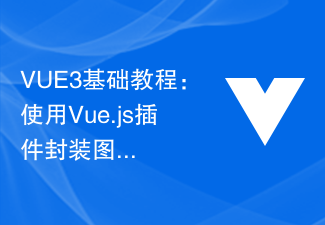 VUE3基础教程:使用Vue.js插件封装图片上传组件Jun 15, 2023 pm 11:07 PM
VUE3基础教程:使用Vue.js插件封装图片上传组件Jun 15, 2023 pm 11:07 PMVUE3基础教程:使用Vue.js插件封装图片上传组件Vue.js是一款流行的前端框架,它使开发者可以用更少的代码创建更高效、灵活的应用程序。尤其是在Vue.js3发布之后,它的优化和改进使得更多的开发者倾向于使用它。这篇文章将介绍如何使用Vue.js3来封装一个图片上传组件插件。在开始之前,需要先确保已经安装了Vue.js和VueCLI。如果尚未安装
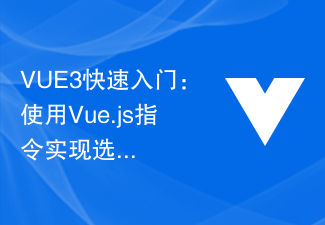 VUE3快速入门:使用Vue.js指令实现选项卡切换Jun 15, 2023 pm 11:45 PM
VUE3快速入门:使用Vue.js指令实现选项卡切换Jun 15, 2023 pm 11:45 PM本文旨在帮助初学者快速入手Vue.js3,实现简单的选项卡切换效果。Vue.js是一个流行的JavaScript框架,可用于构建可重用的组件、轻松管理应用程序的状态和处理用户界面的交互操作。Vue.js3是该框架的最新版本,相较于之前的版本变动较大,但基本原理并未改变。在本文中,我们将使用Vue.js指令实现选项卡切换效果,目的是让读者熟悉Vue.js的
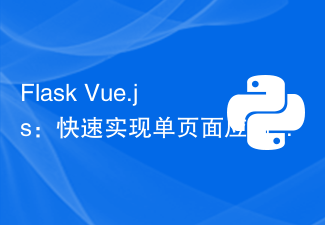 Flask + Vue.js:快速实现单页面应用Jun 17, 2023 am 09:06 AM
Flask + Vue.js:快速实现单页面应用Jun 17, 2023 am 09:06 AM随着移动互联网和Web技术的迅速发展,越来越多的应用需要提供流畅、快速的用户体验。传统的多页面应用已经无法满足这些需求,而单页面应用(SPA)则成为了解决方案之一。那么,如何快速实现单页面应用呢?本文将介绍如何利用Flask和Vue.js来构建SPA。Flask是一个使用Python语言编写的轻量级Web应用框架,它的优点是灵活、易扩
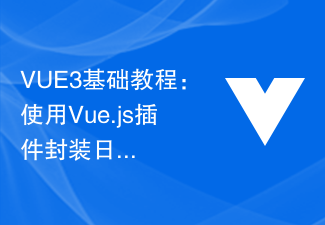 VUE3基础教程:使用Vue.js插件封装日历组件Jun 15, 2023 pm 09:09 PM
VUE3基础教程:使用Vue.js插件封装日历组件Jun 15, 2023 pm 09:09 PMVue.js是现代化的前端JavaScript框架之一,它提供了一套完整的工具来构建交互式用户界面。在Vue.js的生态系统中,有各种各样的插件和组件,可以大大简化我们的开发流程。在本篇文章中,我们将介绍如何使用Vue.js插件封装一个日历组件,以方便我们在Vue.js项目中快速使用。Vue.js插件Vue.js插件可以扩展Vue.js的功能。它们可以添加全
 Vue.js实现登录验证的完整指南(API、JWT、axios)Jun 09, 2023 pm 04:04 PM
Vue.js实现登录验证的完整指南(API、JWT、axios)Jun 09, 2023 pm 04:04 PMVue.js是一种流行的JavaScript框架,用于构建动态Web应用程序。实现用户登录验证是开发Web应用程序的必要部分之一。本文将介绍使用Vue.js、API、JWT和axios实现登录验证的完整指南。创建Vue.js应用程序首先,我们需要创建一个新的Vue.js应用程序。我们可以使用VueCLI或手动创建一个Vue.js应用程序。安装axiosax
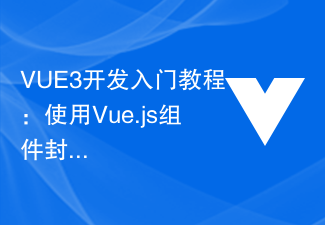 VUE3开发入门教程:使用Vue.js组件封装chart图表Jun 15, 2023 pm 10:29 PM
VUE3开发入门教程:使用Vue.js组件封装chart图表Jun 15, 2023 pm 10:29 PM随着大数据时代的到来,数据可视化已经成为了现如今的趋势之一。在Web前端开发的过程中,如何使用Vue.js进行数据可视化处理,成为了许多前端开发者所关注的问题。本文将会介绍如何使用Vue.js组件,封装基于chart.js库的图表。1.了解chart.jsChart.js是一款基于HTML5CanvasElement的简单易用、跨平台的开源图表库,我们可
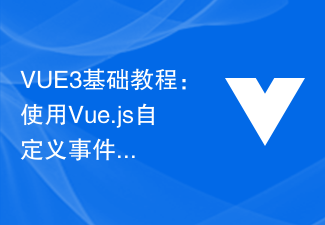 VUE3基础教程:使用Vue.js自定义事件Jun 15, 2023 pm 09:43 PM
VUE3基础教程:使用Vue.js自定义事件Jun 15, 2023 pm 09:43 PMVue.js是一款流行的JavaScript框架,它提供了很多方便的特性,所以它在开发Web应用程序时非常有用。Vue.js中的自定义事件系统使其更加灵活,并且可以通过组件事件触发和处理来实现更好的代码重用性。在本文中,我们将讨论如何使用Vue.js的自定义事件。Vue.js中自定义事件的基础在Vue.js中,我们可以通过v-on指令来监听DOM事件。例如,
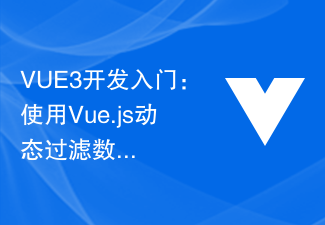 VUE3开发入门:使用Vue.js动态过滤数据列表Jun 15, 2023 pm 09:10 PM
VUE3开发入门:使用Vue.js动态过滤数据列表Jun 15, 2023 pm 09:10 PMVue.js已经成为现代Web开发的中流砥柱。它是一个轻量级的JavaScript框架,提供了数据绑定和组件化的能力,使得开发者能够更加轻松地构建交互型应用程序。而现在,Vue.js的新版本VUE3也已经面世。在本文中,我们将使用VUE3,通过实例,介绍如何在Vue.js中实现动态过滤数据列表。1.准备工作在开始本教程之前,您需要先安装Node.js和Vue


Hot AI Tools

Undresser.AI Undress
AI-powered app for creating realistic nude photos

AI Clothes Remover
Online AI tool for removing clothes from photos.

Undress AI Tool
Undress images for free

Clothoff.io
AI clothes remover

AI Hentai Generator
Generate AI Hentai for free.

Hot Article

Hot Tools

Dreamweaver CS6
Visual web development tools

ZendStudio 13.5.1 Mac
Powerful PHP integrated development environment

Atom editor mac version download
The most popular open source editor

SublimeText3 Mac version
God-level code editing software (SublimeText3)

Safe Exam Browser
Safe Exam Browser is a secure browser environment for taking online exams securely. This software turns any computer into a secure workstation. It controls access to any utility and prevents students from using unauthorized resources.






